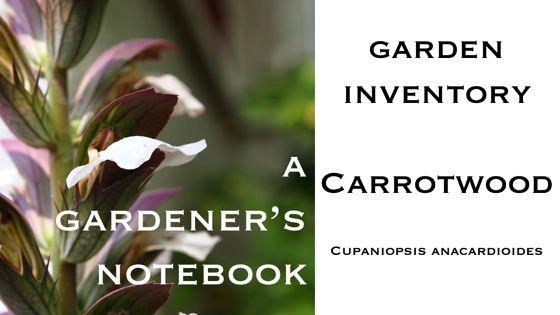Podcast: Play in new window | Download (Duration: 2:52 — 208.9MB) | Embed
Subscribe: Apple Podcasts | RSS
Garden Inventory is a series where I begin an inventory of all the plants and trees in my garden. Along with some of my own pictures, I will link to various sources of information about each plant and tree so we can learn a little more together. As part of the Dog Days of Podcasting, and in order to expand the videos available on my YouTube Channel, this installation of Garden Inventory includes a companion video.
Garden Inventory: Carrotwood (Cupaniopsis anacardioides)
When we purchased our house back in 1996, it was over planted with trees, including probably 10 of these Carrotwood. Over the years, I have edited out 5 or 6 of them to help open up the back garden to more sunlight and reduce competition among the trees. Throughout that process, I have usually kept the carrotwood as they are low to no maintenance and seem to do well whether we are having a wet or dry year. These are quite common trees here in the San Fernando Valley. I often see them as landscape and street trees, especially in new developments. I would imagine this is because they grow fairly quickly.
Carrotwood has a fairly dense growth, but less than the Ficus benjamina, which I also have the in garden. The leaves are similarly heavy and waxy, but there are fewer on each stem, so the overall effect is less heavy.
In most years, Carrotwood will flower and fruit, although this year there seemed to be less. I would guess it depends on the weather and also the pollinators available. I had noticed that trees only a few streets over were heavily fruited, as mine have been in previous years. It seems that there isn’t much wildlife that eats the seeds here, although I have witnessed mockingbirds carrying seeds away in the past.
Carrotwood can be single or multi-trunked, although most in my garden are single. As you might be able to see in the video, the branches in my trees are fairly unkempt and tangled, which I think is mainly due to poor maintenance when they were younger.
Overall, the information on this tree seems to be “DON’T PLANT IT!” Pity I have so many on the property. Hmmm….

Video of Carrrotwood (Cupaniopsis anacardioides) with closeups of leaves, growing habit, and flowers.
Cupaniopsis anacardioides, with common names tuckeroo, carrotwood, beach tamarind and green-leaved tamarind, is a species offlowering tree in the soapberry family, Sapindaceae, that is native to eastern and northern Australia. The usual habitat is littoral rainforeston sand or near estuaries. The range of natural distribution is from Seven Mile Beach, New South Wales (34.8° S) to Queensland, northern Australia and New Guinea.
C. anacardioides is an invasive species in some parts of the United States, primarily Florida and Hawaii.[1]
It is small tree with attractive foliage, growing up to ten metres tall with a stem diameter of 50 cm. The bark is smooth grey or brown with raised horizontal lines. The bases of the trees are usually flanged.
Leaves are pinnate and alternate with six to ten leaflets. These are not toothed, and are egg shaped to elliptic oblong, 7 to 10 cm long. The tips are often notched or blunt. Leaf veins are evident on both sides. The veins are mostly raised underneath.
Greenish white flowers form on panicles from May to July. The fruit is an orange to yellow capsule with three lobes. There is a glossy dark brown seed inside each lobe. The seeds are covered in a bright orange aril. Fruit ripens from October to December, attracting many birds including Australasian Figbird, Olive-backed Oriole and Pied Currawong.
Germination from fresh seed occurs without difficulty, particularly if the seed is removed from the aril and soaked for a few days. – Wikipedia.org
More information on Carrrotwood (Cupaniopsis anacardioides):
- Carrrotwood (Cupaniopsis anacardioides) on Wikipedia
- Carrotwood information and discussion on Dave’s Garden
- Carrotwood info at Center for Aquatic and Invasive Plants, University of Flori
Previously on Garden Inventory:
- Asiatic Dayflower (Commelina communis)
- Honey Locust (Gleditsia triacanthos)
- Aucuba japonioca variegata (Gold Dust Plant)
- Clytostoma callistegioides
- Ficus repens
- Lantana
- Sword Fern (Polystichum munitum)
- Lemon
- Redwood (Sequoia sempervirens)
- Ficus benjamina
- Ash Tree (Fraxinus)
- Black Pine (Pinus nigra)
- Snowflakes (Leucojum)
- Ming Fern Asparagus (Aspargaus retrofractus)
- Paperwhites (Narcissus papyraceus)
- Azalea
- Nandina domestica (Heavenly Bamboo)
- Eucalyptus